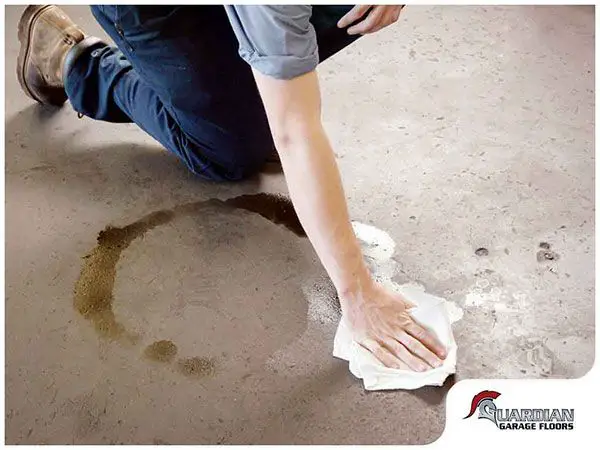Oil stains on a garage floor can be frustratingly difficult to remove. Over time, oil spills can permeate deep into concrete and leave behind dark, unsightly blemishes. Luckily, with some effort and the right cleaning solutions, you can get rid of those pesky oil stains for good.
Page Contents
What causes oil stains on the garage floor?
Oil stains occur when oils like motor oil, transmission fluid, gear oil, or lubricants drip or spill onto the concrete garage floor. As the oil seeps into the pores of the concrete, it leaves behind a stain. This happens because oil contains pigments and compounds that chemically bond to the concrete.
Common causes of oil stains include:
- Oil leaks from your car
- Doing oil changes and dripping used motor oil on the floor
- Spilling oil cans or bottles
- Parking leaky vehicles inside the garage over time
The longer an oil spill sits on the floor, the harder it will be to remove the stain. The oil soak deeper into the concrete, making it very stubborn to get out.
How to remove new oil stains
If you catch an oil spill soon after it happens, you have a better chance of removing the stain more easily. Here are tips for cleaning up fresh oil stains:
- Blot up any excess oil with rags or paper towels immediately.
- Sprinkle the stain heavily with baking soda or cornstarch. This will absorb some of the grease.
- Let it sit for 10-15 minutes before scrubbing.
- Scrub using a stiff brush and degreasing cleaner like dish soap, laundry detergent, or a citrus-based cleaner.
- Rinse thoroughly with hot water.
- Repeat as needed until the stain lifts.
Cleaning up a spill right away prevents the oil from soaking deeper into the concrete. Make sure to rinse thoroughly to get rid of any oil residue.
How to remove old, set-in oil stains
Eliminating older, more stubborn oil stains takes a little more effort. Here are some tips for removing set-in stains:
Try a degreaser
Degreasing cleaners help break down oil and grease stains. Spray or scrub on a heavy duty degreaser like Simple Green, Krud Kutter, or Greased Lightning. Check the product label and let it soak for 5-10 minutes before scrubbing and rinsing.
Use baking soda and vinegar
For a non-toxic option, make a paste with baking soda and vinegar. Apply a thick layer over the stain and let sit overnight before scrubbing and rinsing.
Scrub with TSP substitute
Trisodium phosphate (TSP) is a powerful cleaning agent that cuts through grease stains. Since TSP is not eco-friendly, use a TSP substitute instead. Make a paste and scrub it into the stain.
Pressure wash
For large stains, use a pressure washer to blast away the stained surface layer of concrete. This can help lift years of accumulated oil. Be careful not to damage the underlying concrete.
Use a poultice
A poultice pulls oil up and out of concrete. Mix a paste of cleaning agents like TSP substitute, automatic dishwasher detergent, or hydrogen peroxide with an absorbent filler like kitty litter or flour. Spread it on the stain thickly and cover with plastic. After 24-48 hours, scrape away and rinse.
Tips for removing oil stains by type
Certain types of automotive fluids and oils respond better to specific cleaning solutions. Here are tips for removing stains by oil type:
| Oil Type | Cleaning Solution |
|---|---|
| Motor oil | Dish soap, citrus cleaner, degreaser |
| Transmission fluid | Kitty litter poultice |
| Brake fluid | Pressure wash, baking soda paste |
| Hydraulic fluid | Degreaser, TSP substitute |
| Gear oil | Dish soap, degreaser, TSP substitute |
| Grease | Degreaser, citrus cleaner |
How to seal oil stained concrete
If an oil stain proves too difficult to remove entirely, you can seal the concrete to lock in the stain and prevent further oil penetration. Here are some tips:
- Make sure the concrete is totally clean and dry first.
- Use a high quality concrete sealer like an epoxy or polyurethane.
- Apply 2-3 thin coats, allowing each to dry between coats.
- Thicker applications can peel, bubble or yellow over time.
- Reapply the sealer every 1-2 years.
The sealer forms a protective barrier over the concrete, preventing oil and moisture from seeping in. This helps contain old stains.
How to prevent oil stains
Here are some tips to help avoid oil stains on your garage floor in the future:
- Quickly clean up any spills or leaks.
- Use oil catch mats or drip pans when changing oil.
- Inspect vehicles for leaks and fix them promptly.
- Keep floors swept to avoid grinding in oil.
- Apply a concrete sealer to protect the floor.
- Park vehicles over cardboard or cat litter to absorb drips.
With some diligence, you can keep your garage floors stain-free and looking like new.
Conclusion
Oil stains can be extremely difficult to remove from concrete garage floors, especially once they have set in over time. With the right cleaning solutions and techniques, however, it is possible to eliminate those unsightly marks. Using degreasers, abrasive scrubbing, pressure washing, and absorbent poultices can help lift out the oil. For stubborn stains that won’t budge, sealing the concrete can contain the blemish. With some elbow grease and persistence, you can get rid of oil stains on your garage floor.
